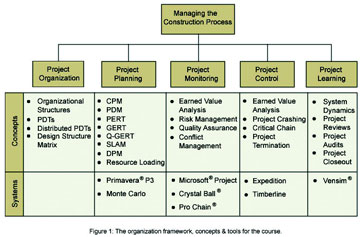Future Trends in Project Management
Lew Ireland, Ph.D
The Changing Project Paradigm
As the price of resources increases, organizations will need to find new and better methods of conducting project work to offset costs while remaining competitive in the marketplace. The recent rise in the prices for gasoline and diesel fuel, with accompanying rise in cost of other resources, is of concern to business leaders.
The increased cost of project resources must be factored into the project's product for passing along to the client. Senior management must find ways to absorb the extra cost of resources or raise the price for products resulting from projects.
Current project management procedures and practices continue to find improvements that can save on the consumption of resources, but there is still room for improvement. Project managers are frequently assigned to projects for the purpose of delivering products that work – often with little regard for the cost – with the emphasis on schedule and technical performance. Project management literature focuses on project manager effectiveness and on functional manager efficiency, with product delivery implied as being the effectiveness. Under current conditions, project managers cannot always be both efficient and effective.
Need For Change
Project management effectiveness and efficiency do not occur by accident or through hope. It takes concerted effort to change from the usual to something better. "It has always been done that way" is a saying (or excuse) that denies the need for change. Random changes to practices often change the outcome without identifying the cause of good or bad results. Continuous change in a random manner cannot bring about the best results. In a 1983 study done by the Construction Industry Institute, there was 47 percent waste in building projects. These areas of waste included rework of the product because the initial job was done incorrectly, installation methods not followed, and the wrong materials were initially used. Waste on the projects resulted in lost time, more cost, and lesser product capability.
More staff was required than planned and more materials were consumed than necessary, which was driving up cost of constructing buildings. It is assumed that other types of projects suffer from similar errors, though it is also recognized that project management has matured significantly over the past 25 years.
Regardless of improvements in project management, there must be new methods of performing that saves on the cost of resources consumed to offset increases in price. Project managers will be looked upon to use fewer resources to reduce the project cost – and perhaps the only way to do this is to eliminate waste from the project. Project waste is typically viewed in seven categories:
- staff time on the project,
- non-human resources such as materials and equipment,
- methods that are not optimized,
- idle time while decisions are pending,
- using the wrong tools for activities,
- weak plan for implementation, and
- wrong skills assigned to the project.
 |
Some of these are perhaps present in every project regardless of size or complexity. There is often a perceived urgency to start the project before planning is complete or before a feasible plan is developed. Plans are frequently discounted for their value in projects with such comments as "the plan never is a realistic path to the results" and "the plan is only good until the first change comes about." A workable plan tells what is to be done and may tell what is not to be done, e.g., Engineering will coordinate all project external interfaces with customers and report same to the project manager, but shall not make changes to the interfaces without specific approval from the project manager. The planning process can identify both weaknesses in the conceptual approach as well as paths that are not feasible options.
Project managers are selected to manage projects in a variety of ways. Many times the project manager is selected because he/she thinks and acts like the senior manager doing the selecting not because of competence in project management practices. Project managers, to have the greatest opportunity for success, must be competent in the three categories of project management – Technical, Contextual, and Behavioral. (See USA National Competence Baseline for details.)
A technically competent individual who does not have the leadership, negotiation, and other behavioral skills has less chance of successfully managing a project. Understanding the contextual aspects of a project provides, for example, the information to support decision making. Project managers are better performer when they are competent in the technical, contextual, and behavioral categories of project management.
 |
Project managers have the luxury of planning their work and working their plan. Many professionals do not have the opportunity to conduct detailed planning, but must work with emerging information about the size, risk, and duration of the event. Firemen, for example, respond to emergency situations with limited knowledge of the scope of a fire and must respond according to newly acquired information on site. Perhaps this is what generated the term "fire fighting." Project management should not be fire fighting, but should be a measured response to the tasks required to complete the projects through a deliverable product that meets the customer's needs.
Possible Improvements
The roles of senior managers and project managers will be defined to clearly show each person's responsibility in planning. Project managers will have improved planning skills that allow guiding a team to develop a plan that includes:
- A clear mission or purpose statement that describes what the project is to accomplish.
- A comprehensive list of facts and assumptions that are related to accomplishing the mission.
- Clear objectives that support the mission or purpose statement.
- A well defined schedule that clearly describes the activities, their durations, and allocated resources.
- The information collection, formatting, and dissemination procedures.
- A description of the periodic review practices.
- A project close-out procedure that includes delivery of the product.
- Other areas of projects such as Risk and Procurement may be required.
Senior managers must review and approve the project plan against some objective criteria. This procedure may entail a review and comment on the project plan by peers or functional managers with a stake in the project. Significant is how closely the project is to be monitored and what is the urgency for the product, which relates to the priority assigned the project.
Senior management may specify that there will be periodic reviews conducted at certain times of progress in the project. Further, if guidance was not initially provided, senior management may designate milestones in the schedule that are owned by the senior manager. A list of possible responsibilities includes the following.
- Select only those projects that contribute to the organization's mission.
- Select projects that fit into the strategic portfolio of project work.
- Select and assign only competent project managers to lead projects.
- Approve or reject project plans that either meet or fail to meet the organization's policy.
- Review and comment upon project progress redirect project direction, when necessary.
- Terminate unproductive projects at the earliest possible time.
Organizations will conduct rehearsals of projects based on approved plans. These rehearsals will comprise two or three days of "war gaming" the project to identify strengths and weaknesses while exercising the core staff. Benefits of the rehearsal will include the following.
- Permit the core team to work together to build relationships and enhance communication among the core team.
- Stress the implementation and close-out phases of the project to determine whether the plan has the right level of detail not too much and not too little.
- Highlight weaknesses in the plan for fixing prior to actual project implementation.
- Smooth out control procedures and information collection points to ensure adequate control over the project.
- Compress the project duration by having a core team that is fully prepared to conduct project work.
- Reduce cost for lost time in rework and decision making by the project manager and senior managers.
Defining roles and responsibilities for projects is key to each person meeting his/her responsibilities. When these responsibilities are undefined, stakeholder develop their respective tasks that my or may not align with the organization's goals. Organizational competence is not optimized unless there is good alignment with the organization's business purpose.
In Conclusion
There is danger in the comfort zone for businesses when leaders become satisfied with the status quo. Change is coming and business leaders need to position to meet these challenges.
Often it takes a crisis to motivate leaders to make change – and that is only because they must adapt to survive. Anticipating and planning for change is difficult because many people feel comfortable with the current environment. Future-looking leaders plan for the future and implement effective changes that meet the new situations that emerge..
Some practices that may play a significant role in improving project management productivity are suggested in this paper. More improvements can be found through research on current practices and assessing the worth of new practices. Improvements may be made internally to project management practices, but the greatest improvement may be changes to organizational management of projects. Organizational competence in project management can perhaps have more dramatic results on project success than improvements in project management practices.
Organizational effectiveness in employing projects to support business goals makes a major contribution to the success of projects. Assessing the organizational structure and business design can identify areas that need improvement to optimize project selection, support, and management in the organization. This would result in better chances for the project manager to deliver products and services that meet the clients' needs.
Organizational practices can either select the right project to meet strategic goals or select one that is in contretemps with the business purpose. Project selection is perhaps the most important aspect of senior management in an organization. Secondly, how the project is supported in actual practice makes a valuable contribution to project success.
Will your organization be thinking ahead of change or responding to crises? The winners will be those anticipating change in time to adjust to the new environment through new and better practices. Will project managers struggle to meet greater productivity goals or will they manage in a professional, measured way? While time designing change for the future is now, let the best business leaders decide what is needed to meet these challenges.
About the Author
 |
Lew Ireland, Ph.D. - is an Executive Project Management Consultant based in Tennessee and serving both US and international clients. He has worked with clients to establish their project management systems to ensure they are supportive of the organizations' respective goals. He is experienced in all phases of project management that include planning, scheduling, project office implementation, project maturity modeling, and project assessment.
Lew has authored or co-authored project management books and articles for professional journals.
|
He is a continual contributor to the American Society for the Advancement of Project Management, regularly writing short articles for our website.
Lew has a history of serving for nearly 25 years in volunteer positions to advance project management. He is past President and Chair of the Project Management Institute and has served in various positions within the Institute. He has been recognized by the Institute for his contributions by the Distinguished Contribution Award, Person of the Year, and elected a Fellow of the Institute.